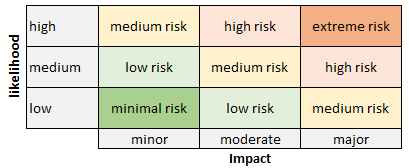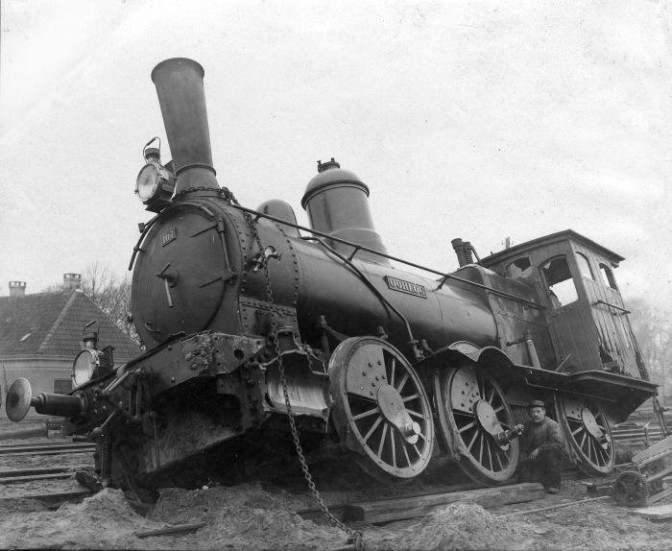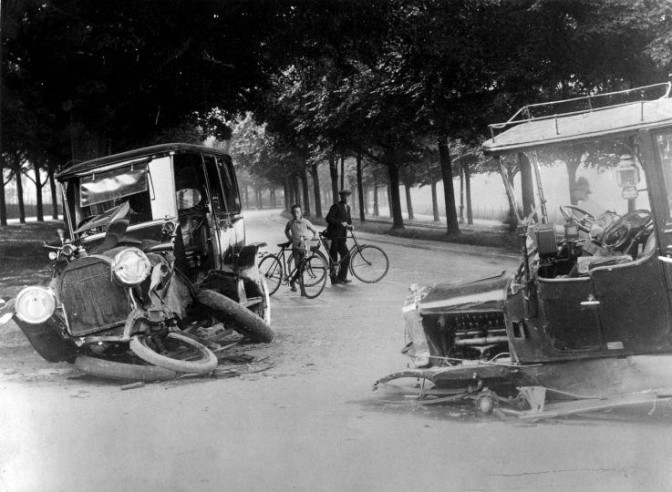As a project manager, I am used to assessing and managing risks. I will determine the biggest threats to my project, assess how likely they are to occur and how much of an impact they would have if they do occur. The combination of these factors will tell me which risks I need to focus my attention on: risk = likelihood x impact.

The same two factors that make up risk can also be used to reduce risk. By taking measures, I can decrease the likelihood that the risk occurs or minimize the impact if it does. I will start by implementing the easy, low-cost measures and re-assess the risk. If necessary, I will take more measures until the risk is at an acceptable level. For example, I may decide to implement a better communication strategy to make sure everybody knows what’s expected (minimizing the likelihood that they are not available when they need to be) or I could hold money in reserve to pay for unforeseen expenses (minimizing the impact of unwelcome surprises).
I use the same approach when doing genealogical research. The first step of the genealogical proof standard is: reasonably exhaustive research. To determine whether my research has been thorough enough to support a conclusion, I assess the risk that my current theory is invalid. If that risk is too high, I will implement measures to reduce that risk until it is acceptably low.
Step 1: Assess the chance that the theory is invalid
To determine how likely it is that my current theory is invalid, I will ask myself:
How likely is it that new evidence will lead me to a different conclusion?
This likelihood depends on the following factors:
- How reliable is this evidence?
This includes an analysis of the sources (original vs. derivative), information contained in the sources (primary or secondary) and type of evidence (direct, indirect or negative)? I also analyze how close to the event the sources were created and whether the sources were created independently. - Does the evidence support this theory?
In addition to assessing the reliability of the evidence, I will correlate the information in all the sources that provide evidence to see if they corroborate or contradict each other. If I have several independent, reliable sources that agree with each other, the chance that new evidence will lead to a different theory is small. If I have conflicting data that I haven’t been able to resolve, for example if two high-quality sources contradict each other, the chance that new evidence will overthrow my theory is higher.
Sometimes, this analysis will make me realize that another theory is more likely to be correct. In that case, I will redo the assessment for the new theory and continue the rest of the steps with the new theory.

Train wreck, 1912. Image credits: Spaarnestad Photo
Step 2: Assess the impact if the theory turns out to be invalid
As genealogists, we always strive for accuracy. Mistakes can mean that we are following the wrong people, who are not our ancestors. For this reason, the impact of errors is never low, but there are cases where mistakes are more serious than others.
- Is the conclusion about relationships?
Examples of conclusions about relationships are determining who the parents of a person are, or who the spouse of a person was. Any errors at this level have a major impact and could potentially lead to severe pruning of the family tree. - Is the conclusion about identity?
Examples of conclusions about identity are determining which of several same-named individuals is the person of interest, or concluding that a person mentioned in record A is the same person mentioned in record B. Any errors about identity also have a major impact and could lead to the wrong people being attached to our tree. - Is the conclusion about a single fact about a person?
Examples of this are knowing an exact birth date for a person, or knowing when a person married. Errors at this level have a medium impact, since they can sometimes be corrected without having to redo part of our tree. For example, if new evidence shows that my ancestor was probably born a day earlier than I had previously thought, this usually does not change the rest of my tree. Of course, an incorrect birth date could lead to identification errors and incorrect trees, so there is no ‘catch-all’ impact assessment as each case will be different.
Step 3: Assess the risk
By combining the chance and likelihood, I can assess how high the risk is that my theory is incorrect. If there is a reasonable chance that my theory is invalid, I will need to take mitigating measures, especially if the impact is high.
Example 1:
If I have a marriage record and a death record for a person, but the parents in both records are different, the chance of me having picked the wrong set of parents is high and so is the impact since it could change my tree. This is an unacceptably high risk. It may well be that I am dealing with two individuals with the same name so I need to sort that out.
Example 2:
If I have a birth record and a population register for a person where the birth date in the birth record is one day earlier than the date in the population register, my theory would be that the birth record is correct since that record was created within five days with an informant who was present at the birth, while the population register is written years later when the birth date was copied from other records. The impact of the one-day-difference would be minimal, so I would consider the risk that the birth date is incorrect to be low.
If the theory has an acceptably low risk of being incorrect, I consider it a conclusion and I’m done. The Genealogical Proof Standard does not require proof beyond any reasonable doubt. A case is considered proven when it is based on reasonably exhaustive, well documented research, where evidence is analyzed skillfully, any conflicts are resolved and the conclusion is written down.1
If the theory has an unacceptable risk of being incorrect, continue with step 4.
Step 4: Take mitigating measures
To minimize the chance of the theory being incorrect, I can take mitigating measures such as:
- Replace low quality evidence with high quality evidence
For example, I can order a scan of a record for which I have only seen a database entry, or try to find eye witness accounts. - Expand the search
For example, I can do research in different types of sources, expand the geographical area of the search, browse sources from cover to cover instead of relying on indexes, search for other name variants or research family members, associates and neighbors (FAN-club).
I will start by taking the measures that are the easiest to do (‘low hanging fruit’), which is usually replacing low quality evidence with high quality evidence. If that doesn’t bring the risk down to an acceptable level, I will expand the search. That could be as simple as trying a wildcard in a search engine or as complex as reconstructing the population of a whole town for an entire century (and yes, I have solved a case doing just that!).
These are all measures that minimize the chance of the risk occurring. I cannot think of any measures that would limit the impact of a mistake, since the impact is inherent to the type of conclusion being made. Or maybe I could open a savings account to set aside some money for someone to redo my tree if it turns out I made a mistake…
Step 5: Rinse and repeat
Go back to step 1 and reassess the risk that the theory is invalid. Rinse and repeat until you reach a conclusion.
Example: birth date in the 19th century
Let’s say that my research question is: when was Jan Jansen born? I have a scan of his birth record, which tells me he was born on 28 October 1853. I also have index entries for Jan’s marriage and death record, that give his age. His age in the marriage record matches the 28 October 1853 birth date, but the age in the death record is off by 10 years. My theory is that his birth date is 28 October 1853.
I start by assessing the reliability of the records. I know that the laws governing birth records make them very reliable: they were created within five working days of the birth, and the informant was either the father or someone who had been present at the birth. The record would have been read aloud to the informant and then signed by him. I have an original record where the date is clearly written and consistent with the dates of surrounding records. The chance that this record is incorrect is low. Similar laws governed the creation of marriage and death records.
I know that indexes are more prone to errors than original records. It is easy to make a typo when entering a number, as in the case of an age. The impact of a mistake in the birth date is not as high as a mistake in other types of conclusions, so my overall risk is pretty low.
There are some easy things I could do to lower the risk even further so I decide to take mitigating measures. I decide to find the scans of the marriage and death records. I find out that a typo was made with the death record and that the age in the original record is a match to the birth date. The information in the original marriage record matched the index entry.
I reassess the chance that my theory is incorrect. There is no more conflicting evidence so I do not need to revise it. I feel that the chances that new evidence will overthrow my theory are so small that I consider my theory proven. Even though there are several other types of records that may provide evidence for Jan’s birth date, such as military records or population registers, I decide my research has been reasonably exhaustive and that my conclusion meets the Genealogical Proof Standard.
What do you think?
What do you think of this approach? Is it helpful to think of genealogical research in terms of risk assessment? Is it ever OK to stop researching if you can think of measures that will minimize the chances of your theory being wrong?

Car wreck, before 1914. Image credits: Spaarnestad Photo
Notes
- For more information about the Genealogical Proof standard, see BCG, Genealogy Standards, 50th-anniversary edition (Nashville, Tennessee: Ancestry, 2014) and Thomas W. Jones, Mastering Genealogical Proof (Arlington, VA: National Genealogical Society, 2013).


As a former audit and risk management executive, this warmed my heart! I lived and died by these standards in my profession. Thanks for carrying the analysis over to our genealogical endeavors!